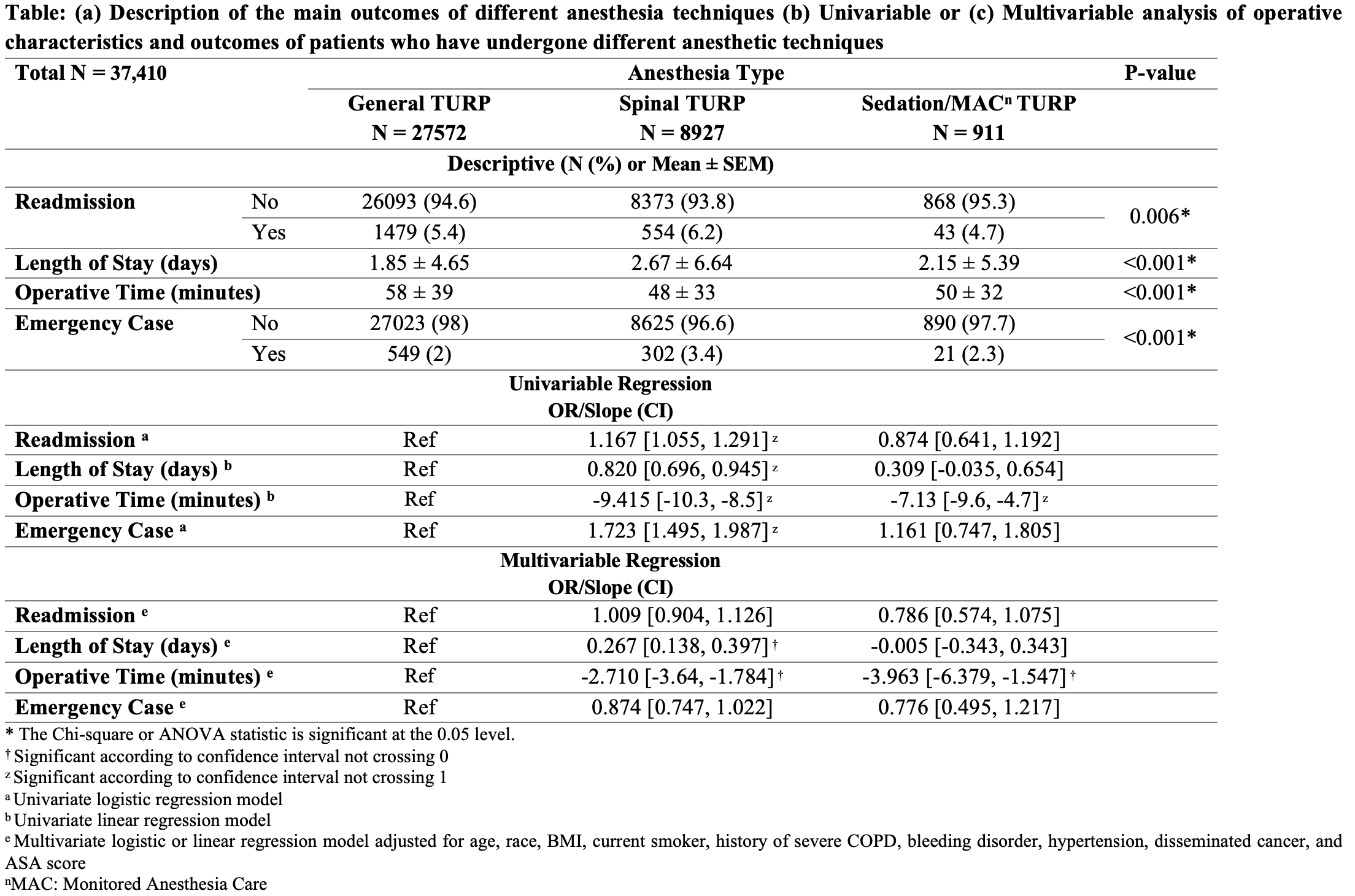Back
Poster, Podium & Video Sessions
MP01: Benign Prostatic Hyperplasia: Surgical Therapy & New Technology I
MP01-15: Sedation as an alternative anesthetic technique for fragile patients in transurethral resection of the prostate
Friday, May 13, 2022
7:00 AM – 8:15 AM
Location: Room 228
Christian Ayoub*, Nassib Abou Heidar, Adnan El-Achkar, Hani Tamim, Albert El Hajj, Beirut, Lebanon

Christian Habib Ayoub, MD, BS
American University of Beirut Medical Center
Poster Presenter(s)
Introduction: Although novel treatments have been introduced to treat benign prostatic hyperplasia, TURP remains the gold standard. TURP is mostly performed using general (genTURP) or spinal (spTURP) anesthesia. Monitored Anesthesia Care MAC/Sedation (macTURP) anesthesia is a safer and infrequently used anesthesia technique reserved for high-risk patients. The aim of this study is to compare 30-day post-operative outcomes of TURP using the three types of anesthesia techniques from the ACS-NSQIP database.
Methods: The ACS-NSQIP database was queried for male patients who underwent TURP for BPH treatment between the years 2005-2017. Demographics, clinical, operative characteristics, and 30-day outcomes were compared. Univariate and multivariate regression models were constructed for selected outcomes.
Results: 37,410 patients underwent TURP for BPH treatment of which 73.3% underwent genTURP, 24% spTURP and 2.4% macTURP anesthesia. Older patients (73) with hypertension (64%), history of COPD (8.1%) and of ASA II/III (51.2%, 6.3% respectively) were more likely to undergo macTURP as compared to genTURP (p-value <0.013). Regarding postoperative outcomes, macTURP showed lower rates of readmission (4.7%) as compared to spTURP and genTURP (p-value= 0.06). MacTURP also showed shorter operative times (50 min) and was more likely to be used in emergency cases (2.3%) as compared to genTURP but longer operative times as compared to spTURP (48 min) (p-value <0.01). MacTURP showed shorter length of hospital stay (2.15 days) as compared to spTURP (2.67 days), but longer length of hospital stays as compared to genTURP (1.85 days) (p-value <0.01). In terms of return to operative room, occurrence of pneumonia, urinary tract infection, sepsis and bleeding requiring transfusion there was no significant difference between the 3 anesthetic techniques. Multivariate analysis showed macTURP had lower operative time by 4 mins and spTURP by 2.7 mins as compared to genTURP. No other significant difference was seen in the multivariate analysis.
Conclusions: TURP under sedation was found to be feasible with a good safety profile. Sedation could be used in elderly, fragile and co-morbid patients providing them less post-operative complications and shorter operative times as compared to more invasive anesthetic techniques.
Source of Funding: None

Methods: The ACS-NSQIP database was queried for male patients who underwent TURP for BPH treatment between the years 2005-2017. Demographics, clinical, operative characteristics, and 30-day outcomes were compared. Univariate and multivariate regression models were constructed for selected outcomes.
Results: 37,410 patients underwent TURP for BPH treatment of which 73.3% underwent genTURP, 24% spTURP and 2.4% macTURP anesthesia. Older patients (73) with hypertension (64%), history of COPD (8.1%) and of ASA II/III (51.2%, 6.3% respectively) were more likely to undergo macTURP as compared to genTURP (p-value <0.013). Regarding postoperative outcomes, macTURP showed lower rates of readmission (4.7%) as compared to spTURP and genTURP (p-value= 0.06). MacTURP also showed shorter operative times (50 min) and was more likely to be used in emergency cases (2.3%) as compared to genTURP but longer operative times as compared to spTURP (48 min) (p-value <0.01). MacTURP showed shorter length of hospital stay (2.15 days) as compared to spTURP (2.67 days), but longer length of hospital stays as compared to genTURP (1.85 days) (p-value <0.01). In terms of return to operative room, occurrence of pneumonia, urinary tract infection, sepsis and bleeding requiring transfusion there was no significant difference between the 3 anesthetic techniques. Multivariate analysis showed macTURP had lower operative time by 4 mins and spTURP by 2.7 mins as compared to genTURP. No other significant difference was seen in the multivariate analysis.
Conclusions: TURP under sedation was found to be feasible with a good safety profile. Sedation could be used in elderly, fragile and co-morbid patients providing them less post-operative complications and shorter operative times as compared to more invasive anesthetic techniques.
Source of Funding: None


.jpg)
.jpg)